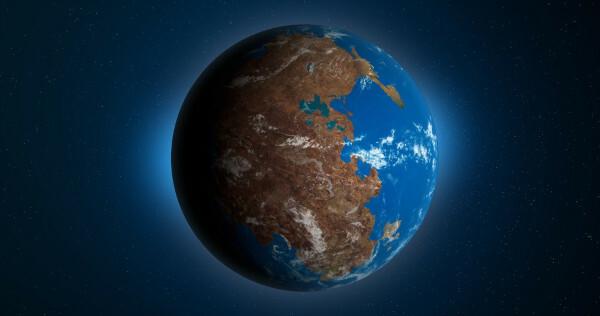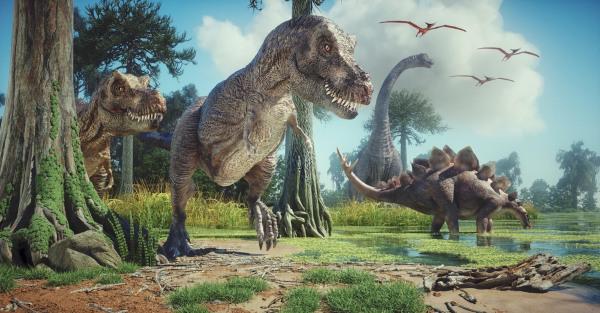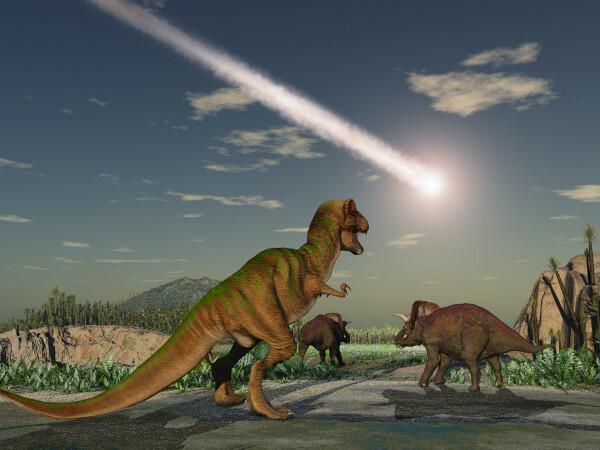A Mesozoic Erait was a geological era which spanned from 251 million years to 65.5 million years in the past. It began immediately after the great extinction that marked the end of the Permian Period, and was characterized by the emergence of a variety of animal and plant species, with emphasis on reptiles, mammals and birds, and, in the plant kingdom, on angiosperms. The Mesozoic Era was divided into three periods:
Triassic;
Jurassic;
Cretaceous.
Its highlight was the dinosaurs, which appeared during the Triassic. In the subsequent period, there was a multiplication of species and the population of dinosaurs in general. During the Cretaceous, however, these animals became extinct as a result of an asteroid impact.
It was in the Mesozoic Era that Pangea fragmented and gave rise to two other large continents: Laurasia and Gondwana. The drift of the continents continued the process of opening the Atlantic Ocean and the formation of new continental masses, and, at the end of the Cretaceous, the earth's surface acquired its configuration current.
Read too: Dinosaurs — details about the famous reptiles that lived on Earth during the Mesozoic Era
Summary about the Mesozoic Era
The Mesozoic Era was a geological era of the Phanerozoic Eon, extending from 251 million years to 65.5 million years in the geological past.
-
It was divided into three geological periods:
Triassic;
Jurassic;
Cretaceous.
The Permian Period, of the Paleozoic Era, preceded the beginning of the Mesozoic. It was marked by the formation of Pangea and the largest mass extinction ever recorded.
The Mesozoic Era was characterized by the development of the reptile class and the emergence of mammals, birds and plants from the angiosperm group.
The climate was hot and dry, with variation in moisture content in the region of the Earth's equator.
It was during it that dinosaurs emerged (Triassic) and also became extinct (Cretaceous).
It was marked by the fragmentation of the supercontinent Pangea into Laurasia and Gondwana and, also, by the separation of these two blocks from each other, starting the process of establishing continents and oceans as they are today. We know.
What was the Mesozoic Era?
The Mesozoic Era was a geological era of Éon Phanerozoic (542 millions of years -Ppresent) that extended from 251 million years to 65.5 million years in the geological past, lasting approximately 185 million years. Known as the era of reptiles and marked by the emergence and extinction of dinosaurs, the Mesozoic Era was subdivided into three different periods:
Triassic (251 to 100 million years old);
Jurassic (200 to 146 million years);
Cretaceous (146 to 65.5 million years).
The word Mesozoic means “middle life” or “intermediate”, referring to the emergence of new forms of life after the great extinction that occurred during the period that preceded the beginning of this geological era.
Background of the Mesozoic Era
The Mesozoic Era began immediately after the end of the Permian (299-251 million years ago), which marked the end of the Paleozoic Era (542-251 million years ago). During the Permian, the last tectonic movements took place that conditioned the formation of the supercontinent known as Pangea, which consisted of a single block of emerged land formed by all the continents we know today. Therefore, during the Permian, the shallow seas disappeared as Pangea was structured.
As a result of the formation of this enormous continental mass, the climate of planet Earth underwent significant changes in the period leading up to the Mesozoic Era. The formation of very arid deserts and the development of a less severe climate close to the Earth's equator were identified, in addition to the emergence of an icy cover in the South Pole region. Climate change in coastal areas caused marshes to dry out, and many animal species that lived in these environments became extinct.

The Paleozoic Era was marked by great glaciations and episodes of mass extinction of animals, although it was during this era that terrestrial, animal and plant life ceased to be merely microscopic. Furthermore, species conquered continents and became terrestrial during this geological era. In the Permian, it is worth highlighting the development of mammal precursors and the growth in the number of reptiles.
Nonetheless, at the At the end of the Permian, approximately 96% of terrestrial life wasram extinctyou in an event that became known as the greatest mass extinction ever it happenedon planet Earth. The cause is believed to have been volcanic eruptions of great magnitude, temperature variations and meteor impacts.
Characteristics of the Mesozoic Era
The Mesozoic Era he was an intermediate geological eraibetween the one that inaugurated the Phanerozoic Eon and the current era, known as the Cenozoic. The Mesozoic began approximately 251 million years ago, shortly after the great extinction that marked the end of the Permian. The Mesozoic Era lasted 185 million years, and was marked by events of great importance that redefined the configuration of the Earth's crust and the forms of life on planet Earth.
Although the first terrestrial reptiles appeared in the Carboniferous Period of the Paleozoic Era, the Mesozoic era was known as the era of reptiles due to the great evolution observed in this class of animals, both with regard to the origin of new species and the development of existing ones. Not only did reptiles evolve, but many other classes and species of animals and plants also appeared during the Mesozoic.
During the early Mesozoic, Pangea was formed, and the world was therefore composed of a single continent and a single ocean, called Panthalassa. He was in the Mesozoic Era thatto Pangea began and ended its fragmentation. The climate of planet Earth in the Mesozoic was, in the beginning, very hot and dry, giving rise to a series of large deserts across Pangea. Temperatures remained high throughout this era, although variations in humidity were observed, especially along the equator of the Earth's sphere.
Periods of the Mesozoic Era
→ Triassic (251 to 100 million years old)
The Triassic was the first period of the Mesozoic Era, extending from 251 to 250 million years ago. It came on the heels of the Permian, when a great extinction wiped out most of Earth's life. In the Triassic, many forms of animal and plant life emerged, with emphasis on the first dinosaurs and marine reptiles, like turtlesgto the, It is you flying. The main animals of this period were terrestrial, including some mammals, which, however, were still fewer in number.

Unlike the preceding era, the climate at the beginning of the Mesozoic was very hot and dry, and the ice cover at the Earth's northernmost pole ceased to exist. Despite this apparently adverse condition, gymnosperms increased their presence during this period, as did cycad-type plants and conifers. Next to them were ferns, classified as pteridophytes.
It is also important to point out that the breakup of Pangea began in the Triassic. In addition to this separation, the supercontinent would fragment once again in the Mesozoic Era.
→ Jurassic (200 to 146 million years)
A new extinction marked the end of the Triassic and the beginning of the Jurassic, a period that lasted from 200 to 146 million years ago. The Jurassic yousee the main characteristic is the emergence of new species of dinosaurs, with emphasis on brontosaurus, titanosaurs and tyrannosaurs. Birds also originated during the Jurassic, along with new marine species and small mammals that lived underground, such as rats.

Planet Earth's climate acquired tropical characteristics, and plants such as conifers and cycads spread over the Earth's surface.
Pangea, which had begun to fragment during the Triassic, continued its movement apart during the Jurassic. At the end of this period, we had two supercontinents containing the planet's emerging lands: Laurasia and Gondwana. Therefore, it can be said that it was also in the Jurassic period that the oceans, mainly the Atlantic, began to form as we know them today.
→ Cretaceous (146 to 65.5 million years)
The Cretaceous was the period that began shortly after the end of the Jurassic, stretching from 146 to 65.5 million years ago. It was, therefore, the last period of the Mesozoic Era. At the beginning of the Cretaceous, many dinosaurs and other classes of animals, such as mammals and birds, now have new species and a greater number of representatives. The development of angiosperms, plants that bear flowers and fruits, was accompanied by the appearance of insects such as bees, butterflies and ants.

During the Cretaceous, the Atlantic Ocean continued its expansion, and the breakup of Gondwana gave rise to rifting off the west coast of Africa and the east coast of South America. In fact, during this period the geographical configuration of both regions mentioned was already identified. In the Northern Hemisphere, North America, Asia, and Europe also consisted of isolated fragments of land. Like this, to the end of Cretaceous, the earth's surface acquired its current configuration.
Planet Earth's climate remained warm, varying between hot and temperate areas, which was due to currents maritime seas that were formed thanks to the difference in temperature between the waters of the shallower, warmer seas and those that are warmer. deep.
The Cretaceous came to an end 65.5 million years ago, with the fall of an asteroid on the Earth's surface, whose impact It was devastating for the planet, mainly in terms of biodiversity. The asteroid collided with Earth in the Gulf of Mexico region, in the current Yucatan peninsula, and the effects produced due to the impact, they caused the extinction of dinosaurs and the loss of 80% of all animal and plant life present in our country. planet.
End of the Mesozoic Era
The end of the Mesozoic Era happened 65.5 million years ago in the geological past, marked by the fall of an asteroid and the extinction of most of the biodiversity present on the planet. At the end of this era, therefore, dinosaurs ceased to exist. Furthermore, the continents and oceans began to acquire their current configuration.
Geological time scale
The chronological time line traced from the beginning of the formation of planet Earth to the present is called the geological time scale. This time scale is measured in billions and millions of years, and records all the processes of evolution and transformation of our planet and the animal and plant life that lives on it. The geological time scale is divided into:
Aeons: are the longest intervals of time and counted in billions or millions of years, in the case of the most recent eon. Geological time was divided into four eons, and each of them is divided into geological eras.
Geological eras: are the subdivisions of eons at intervals of billions (in the case of the Proterozoic Eon) or millions of years. There are six geological eras in total.
Periods: are subdivisions of geological eras. Each period varies in duration from a few hundred to tens of millions of years. The eras that are subdivided into periods are: Paleozoic, Mesozoic and Cenozoic.
Seasons: are subdivisions of periods and correspond to the shortest time intervals on the geological time scale.
Also access: What is the difference between historical time and geological time?
Exercises on the Mesozoic Era
Question 1
(UFF) Select the option that indicates the geological period characterized by the disappearance of dinosaurs:
A) Devonian
B) Jurassic
C) Triassic
D) Cambrian
E) Cretaceous
Resolution:
Alternative E
Dinosaurs disappeared when, more than 65 million years ago, an asteroid collided with Earth. This happened during the Cretaceous, the last period of the Mesozoic Era.
Question 2
(Udesc) The Continental Drift Theory was enunciated by the German scientist Alfred Lothar Wegener, in 1912. According to this author, the Earth would have initially been formed by a single and enormous supercontinent, which fragmented and moved continuously since the Mesozoic Period, as if it were a kind of cream floating on a semi-liquid magma and traveling in different directions.
Select the alternative that contains the name with which this initial supercontinent was baptized.
A) Gaia
B) Plate Tectonics
C) Wegener Shales
D) Riftis
E) Pangea
Resolution:
Alternative E
Pangea is the name of the supercontinent that was formed at the end of the Paleozoic and beginning of the Mesozoic, having separated in this last geological era.
Sources
TEIXEIRA, Wilson.; FAIRCHILD, Thomas Rich.; TOLEDO, Maria Cristina Motta de; TAIOLI, Fabio. (Eds.) Deciphering the Earth. São Paulo, SP: Companhia Editora Nacional, 2009, 2nd ed.
YOUTH AND EDUCATION IN SCIENCE (YES). Mesozoic. United Stated Geological Survey (USGS), [n.d.]. Available in: https://www.usgs.gov/youth-and-education-in-science/mesozoic.
YOUTH AND EDUCATION IN SCIENCE (YES). Paleozoic. United Stated Geological Survey (USGS), [n.d.]. Available in: https://www.usgs.gov/youth-and-education-in-science/paleozoic.
Source: Brazil School - https://brasilescola.uol.com.br/geografia/era-mesozoica.htm

